Every now and again I re-read a favourite butterfly book, the most recent being E.B. Ford's classic Butterflies, first published in 1945 as part of Collins' New Naturalist series. The first chapter of Butterflies is dedicated to "The History of British Butterfly Collecting" and traces the first mention of various species found in the British Isles. This is an incredible piece of work and an absolute credit to one of my greatest influences.
In addition, I'd like to credit the army of individuals that deliver content to the Internet - surely the greatest of resources (so long as you look in the right place!). Of the many online resources I've consulted, it would be remiss of me were I not to mention Google Books and the Internet Archive. These resources have fulfilled many of my expectations, by making available to me the content of books that I could never have accessed without spending a significant amount of time (and money) visiting museums and personal collections.
And so - what you find below is a summary, in chronological order, of the first description of each of species on the British list. All comments and corrections are welcome. And any errors are, of course, mine.
|
Insectorum sive Minimorum Animalium Theatrum ("The Theatre of Insects") is published (in Latin) under Thomas Moffet's name (the father of "Little Miss Muffet" and whose surname is spelled in various ways - including Moffet, Moffat, Mouffet and Muffet), although it had received significant contributions from Conrad Gesner, Thomas Penny and Edward Wotton. This book describes (but does not name) several British species. These are generally recognised to be Black-veined White, Brimstone, Clouded Yellow, Comma, Common Blue, Dark Green Fritillary, Green-veined White, Large Tortoiseshell, Large White, Orange-tip, Painted Lady, Peacock, Red Admiral, Silver-spotted Skipper, Small Tortoiseshell, Small White, Speckled Wood, Swallowtail and Wall. In addition, Moffet mentions Apollo, Camberwell Beauty and Scarce Swallowtail, although these are not claimed to be British. It is quite fitting that the Brimstone is one of the first species to be described since it is generally agreed that the word "Butterfly" is derived from the description of a "Butter-coloured Fly" that the Brimstone epitomises.
|
| Pinax rerum Naturalium Britannicarum: continens Vegetabilia, Animalia, et Fossilia, in hac Insula reperta Inchoatus (often referred to simply as "Pinax"), by Christopher Merrett, is published - also in Latin. This book describes (but, again, does not explicitly name) 21 British species, including some for the first time: Dingy Skipper, Gatekeeper, Green Hairstreak, Marbled White, Meadow Brown, Purple-edged Copper, Ringlet, Small Heath, Small Pearl-bordered Fritillary and Wood White. The inclusion of the Purple-edged Copper is the most remarkable, leading us to believe that this species was once found in Britain.
|
A Grizzled Skipper is recorded by James Petiver at Hampstead Heath. Petiver was a prolific writer and was well-connected: "We owe many of the first records of British insects to the broadsheets, pamphlets and other writings published by Petiver between 1695 and 1717 ... Petiver seems to have acted as the documentary spider at the centre of a web of correspondence" [Salmon].
William Vernon records a Duke of Burgundy from Cambridgeshire.
|
| Petiver describes several British species for the first time: Grayling, Heath Fritillary, High Brown Fritillary, Pearl-bordered Fritillary and Silver-washed Fritillary. |
A female Bath White is recorded by William Vernon from Gamlingay in Cambridgeshire. Petiver subsequently figures the specimen in 1717, in his Papilionum Britanniae Icones, alongside a male Bath White taken at Hampstead. Petiver, believing the male and female to be different species, names them "The slight greenish Half-mourner" and "Vernon's greenish Half-mourner" respectively.
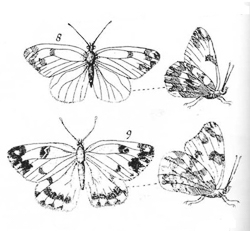 | | Male (top) and Female (bottom) Bath White |
|
James Petiver describes Purple Hairstreak and Queen of Spain Fritillary for the first time. Although Petiver described the Queen of Spain Fritillary from a Latvian specimen (and referred to it as the "Riga Fritillary"), it is believed that the first British specimens were caught around the same time from Gamlingay, Cambridgeshire, by William Vernon and others.
|
Petiver describes Brown Hairstreak, White Admiral and White-letter Hairstreak for the first time.
Glanville Fritillary is recorded by Lady Eleanor Glanville while visiting Lincolnshire. She sends some specimens to James Petiver who goes on to illustrate it in his Gazophylacii naturae et artis, naming it the Lincolnshire Fritillary. There were several subsequent name changes and, after Lady Glanville's death in 1709, is ultimately renamed in her honour by James Dutfield in 1748. |
| Petiver describes Brown Argus, Chalk Hill Blue, Large Skipper, Purple Emperor and Small Skipper for the first time. |
Historia Insectorum, by John Ray, is published posthumously five years after the author's death. This book (again, in Latin) describes 48 species of butterfly that are believed to be British, including the following that are described for the first time: Holly Blue, Marsh Fritillary, Mazarine Blue, Scarce Swallowtail and Small Copper. However, the author does treat the Scarce Swallowtail as a mere recollection and this record is, therefore, uncertain. Subsequent sightings of this species are discussed in detail in [Salmon]. Ray also mentions Camberwell Beauty, but does not claim it as a British species.
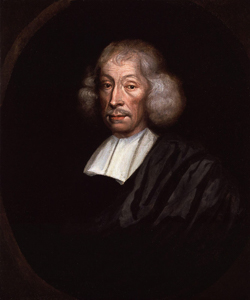 |  | | John Ray |
|
|
James Petiver publishes Papilionum Britanniae Icones in which he describes Albin's Hampstead Eye. This is an Indo-Australasian species (Junonia villida) and it is thought that Albin (who provided Petiver with this specimen) had inadvertently misplaced this specimen in his collection, believing he had taken this individual at Hampstead Heath, which was a popular site for naturalists at the time.
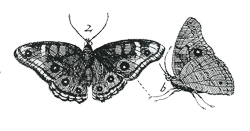 | 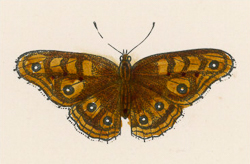 | 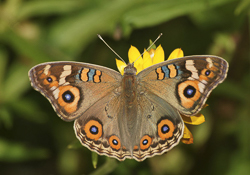 | | Petiver's Engraving | 1853 Illustration of Albin's specimen by F.O.Morris | Junonia villida
Image © David Cook |
|
|
Maurice Johnson, founder and secretary of the Spalding Gentlemen's Society, presents the society with a Large Copper taken at Dozen's Bank, West Pinchbeck, near Spalding in Lincolnshire.
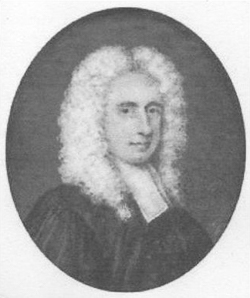 | | Maurice Johnson |
|
The English Moths and Butterflies: Together with the Plants, Flowers and Fruits whereon they Feed, by Benjamin Wilkes, is published in which Camberwell Beauty (the "Willow Butterfly") is described as British for the first time.
|
| Scotch Argus is recorded between 1760 and 1769 (the exact date is unknown) by Dr. John Walker (Professor of Natural History at Edinburgh University) from the Isle of Bute. Tradition has it that the Scotch Argus was first recorded by Sir Patrick Walker in 1804 when he first discovered the Arran Brown on the Isle of Arran. However, specimens have come to light that were taken much earlier, the earliest of which is mentioned here. |
Scarce Copper is recorded from the Warrington area (formerly in Lancashire, now Cheshire) by naturalist Johann Reinhold Forster in his A Catalogue of British Insects. Forster says that the species was in such good numbers that he was able to give specimens to other collectors.
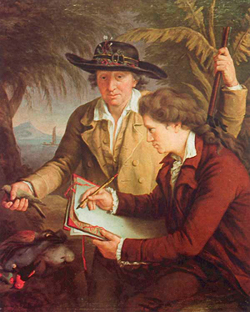 | | Johann Reinhold Forster and his son, Georg, in Tahiti |
|
|
Moses Harris is most famous for The Aurelian, published in 1766. Although that publication introduced no new species, his second work, The English Lepidoptera, or, the Aurelian's Pocket Companion, describes Adonis Blue and Pale Clouded Yellow for the first time, although this pocket companion, unlike its predecessor, is unillustrated. Harris also provides the first definitive record of Silver-studded Blue although it was almost certainly known to entomologists of an earlier generation.
 | 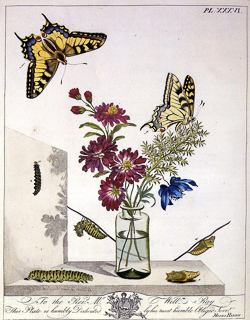 | | A Self-Portrait of Harris | A plate from The Aurelian |
|
|
| A collector called Jones takes several specimens of Northern Brown Argus from Arthur's Seat in Edinburgh. The species is figured 2 years later in Lewin's The Papilios of Great Britain with the name "Brown White Spot".
|
The Papilios of Great Britain, by William Lewin, is published. This book describes the following species for the first time: Large Blue, Large Heath (known as the "Machester Argus" and with the incorrect specific name hero which applies to the Scarce Heath of central Europe), Small Blue (with the specific name alsus) and Turquoise Blue (known as the "Glossy Blue" and with the specific name hyacinthus). It has also been noted that the Large Blue has been accurately added to Henry Seymer's personal copy of Harris' The Aurelian which predates Lewin's work by some 20 years [Salmon].
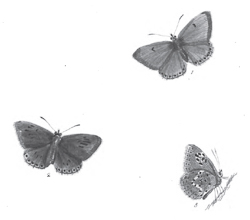 | 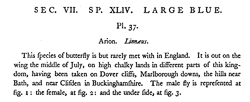 | | Large Blue | Large Blue |
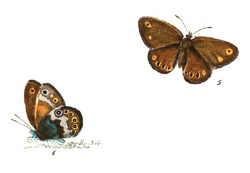 |  | | Large Heath | Large Heath |
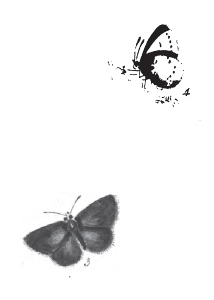 |  | | Small Blue | Small Blue |
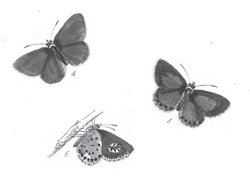 |  | | Turquoise Blue | Turquoise Blue |
|
|
| A Chequered Skipper is captured at Clapham-Park Wood in Bedfordshire and is presented to the Linnean Society by the Revd. Dr. Charles Abbott. The specimen is figured the following year (alongside a male Large Skipper) in volume 8 of Edward Donovan's multi-volume work, Natural History of British Insects a year later with the scientific name Papilio paniscus. Donovan's publication has a wonderful subtitle: Explaining them in their Several States, with the Periods of their Transformations, their Food, Oeconomy (sic), etc. Together with the History of Such Minute Insects as require Investigation under the Microscope.
|
| Haworth reports that he had "heard" of a British specimen of Apollo taken in Scotland. Donovan subsequently includes it in volume 13 of Natural History of British Insects. Several additional sightings are made in subsequent years and the consensus is that some of these, especially on the east coast, are of genuine immigrants.
|
| Arran Brown is found by Sir Patrick Walker from the Isle of Arran and is described in The British Miscellany: or coloured figures of new, rare, or little known animal subjects by James Sowerby. While there is no dispute over the records, there has certainly been dispute over whether the individuals captured were of natural origin, a dispute that has raged to this day. [Salmon] spends 3 entire pages discussing the topic in detail. Nonetheless, it cannot be denied that the occurrence of this species in Britain is now part of our folklore.
|
| Mountain Ringlet is recorded by T.S. Stothard from Ambleside in Cumbria, although this particular sighting was originally attributed to a sighting in Scotland that has since been corrected. |
| Two specimens of Fiery Skipper are caught by W. Raddon from a location near Barnstaple, Devon (around 1820 - the exact date is not known), shortly after a ship from North America had unloaded its cargo. It is believed that the immature stages had been transported in the ship, resulting in the butterflies that were seen. The species (figured under the name Pamphilus bucephalus) is subsequently figured in volume 1 of Illustrations of British entomology; or, A synopsis of indigenous insects: containing their generic and specific distinctions by James Francis Stephens in 1828.
|
| Weaver's Fritillary is taken [in the "1820s"] by Mr. Richard Weaver at Sutton Park, near Tamworth, Warwickshire. This record and all that follow have been disputed since this species is not known to migrate and no established colonies have ever been discovered in the British Isles. |
|
British Entomology, by John Curtis, is published between 1824 and 1839. Volume 6 (published in 1829) describes the Black Hairstreak as having been recorded by Mr. Seaman the previous year. The location is given as Yorkshire which is later determined to be incorrect, Seaman wanting to keep the location of his precious find to himself. The correct location is, in fact, Monks Wood in Cambridgeshire.
|
| The Magazine of Natural History, edited by John Claudius Loudon, Edward Charlesworth and John Denson, is published. In volume 3, J.C.Dale publishes a record of an American Painted Lady (under the scientific name Vanessa huntera) which was captured by Captain Blomer at Withybush, near Haverfordwest, Pembrokeshire in 1828.
|
| Lulworth Skipper is recorded in volume 10 of John Curtis' British Entolomology as having been captured by James Charles Dale in 1832 in the area around Lulworth Cove in Dorset, the first specimen being caught at Durdle Door to the west.
A single Great Spangled Fritillary (originally incorrectly identified as an Aphrodite Fritillary) is captured by a 19-year old amateur entomologist, James Moreton Walhouse, in Ufton Wood near Leamington, Warwickshire. It is believed that the individual was accidentally transported to Britain in an immature stage. The specimen is ultimately passed to Rev. William Thomas Bree who reports it in volume 4 of Loudon's The Magazine of Natural History in 1840. A full description of this record and photos of the actual specimen can be found on the UK Butterflies website.
|
| A Hermit is reared by A. Lane from a larva found at "Newington" (most likely in Kent) and is subsequently exhibited at a meeting of the Entomological Society on 7th October 1839. It is believed that the larva was either accidentally imported, or that the specimen was muddled in the collection. The specimen is figured alongside illustrations of Gatekeeper in British Butterflies and their Transformations by Henry Noel Humphreys and John Obadiah Westwood in 1841.
|
| A Niobe Fritillary is captured in Kent (determined from old records and labelled specimens). However, this species is considered "doubtfully British" since unethical dealers were widespread during this period and would sell continental specimens as British. |
| A Long-tailed Blue is captured on 4th August 1859 by Mr. N. McArthur on the downs near Brighton, East Sussex. Amazingly, Captain A. de Latour catches another specimen on exactly the same day at Christchurch, Hampshire (now in Dorset). |
| Several specimens of Oberthür's Grizzled Skipper are taken during May and June by Revd. T.H. Marsh, on the edge of a wood in Norfolk. It is believed that they were accidentally introduced in plants that had been transported by ship from the continent. It is subsequently figured in volume 1 of Barrett's The Lepidoptera of the British Islands in 1893 under the scientific name Syrichthus alveus (and is the "grizzled" skipper shown furthest down the plate).
|
| A Spotted Fritillary is recorded in June by William Lennon near Dumfries, south-west Scotland and is believed to be an accidental introduction. |
| A Cleopatra is recorded from Ventnor, Isle of Wight. This particular specimen is housed in the British Museum of Natural History (BMNH). This species is not considered to be migratory and its presence has been attributed to passage by ship. |
| A pair of Short-tailed Blue is caught near Frome in Somerset, although these records only come to light some years later. Up until that time, the earliest record was considered to be that of the Rev. Octavius Pickard-Cambridge on Bloxworth Heath, Dorset in 1885, as described in The Entomologist, and from where this species received its alternative vernacular name of the "Bloxworth Blue". |
| A single Berger's Clouded Yellow is caught in Folkestone. However, this sighting in Britain was only discovered after 1945 when this species was separated from the Pale Clouded Yellow. |
| A Monarch is recorded by Mr. J. Stafford, a 14 year-old, at Neath in South Wales. Other individuals were captured in Sussex and Dorset shortly afterward. |
| A Spanish Festoon is recorded in Brighton, Sussex. It is believed to have been accidentally imported as a pupa since this species is not migratory. |
| A single specimen of Southern Festoon is caught by two boys on 27th May near Exeter, Devon. It is believed that is was originally purchased as a pupa from a natural history dealer since this species was available at the time. |
| A single specimen of Purple-shot Copper is captured in July by a schoolboy, F.G. Johnson, near Sudbury in Suffolk. It is thought that the specimen was transported as an immature stage in plants from the continent. |
Two specimens of Dappled White, along with a female Bath White, are caught by C.E. Prince, a schoolboy, in August on the Castle Heights, Dover. These specimens are considered to be "doubtfully genuine" and may have been accidentally imported with animal foodstuff or seeds.
A single specimen of Small Apollo is recorded on 1st September by E.W.S. Swabe, a pupil at Marlborough College, in the mountains above the Penrhyn slate quarries, about 7 miles from Bangor in Caernarvonshire, Wales. It is believed that this was either a deliberate release of a captive-bred individual, or the result of an immature stage that had been imported in alpine plants (the primary foodplant being Yellow Saxifrage, Saxifraga aizoides), which are grown in rock gardens.
A Sooty Copper is recorded by C.A. Latter in August at Lee, near Ilfracombe, Devon. This species is not considered migratory and its appearance on the north Devon coast is therefore suspect. |
| Records of Essex Skipper, captured in 1888, are noted by Mr. Hawes in The Entomologist. The records are subsequently found to originate from St. Osyth in Essex.
|
| A Cardinal is recorded by A.W. Bennett near Tintagel in north Cornwall. This and subsequent sightings, especially those on the south coast, are considered to be the result of genuine immigration, given that this species has a powerful flight. |
| Map is deliberately introduced into the Forest of Dean, Monmouthshire and Symond's Yat, Herefordshire. However, a genuine reason for this species being on the British list is the sighting of a single individual by D. Down at Friday Street, near Dorking, when it was disturbed among bilberry. A large immigration of other species, such as Red Admiral, was underway at the time. |
| A specimen of Almond-eyed Ringlet is captured by King from the mountains east of the Bridge of Orchy, Argyll. The precise date of captured is unknown - King collected from 1880 to 1914. |
| 3 specimens of Slate Flash are recorded on 22nd August by J.W. Cardew in Savernake Forest, Wiltshire. These specimens, originally misidentified as Long-tailed Blue, are believed to have been the offspring of a female accidentally transported from India. |
A male and female Mallow Skipper are recorded in June by Baron J.A. Bouck in Surrey, flying in the vicinity of the larval foodplant, Common Mallow. It is generally believed that they were accidentally introduced since this species is not migratory.
A Moorland Clouded Yellow is recorded in July near Lewes, Sussex, flying with Clouded Yellow. Although this species is not particularly migratory, it is believed that individuals may get caught up in a stream of other immigrants. Another theory is that individuals are accidentally imported as pupae, on alpine plants, from the continent. |
| A Large Wall is recorded at Shrewsbury, Shropshire. It is believed that this individual is the result of accidental introduction. |
| A Tiger Swallowtail is recorded in late September (or early October) by a schoolboy at Bray, County Wicklow, Ireland. It is believed to have been accidentally imported from North America. |
| A Zebra butterfly emerges in December from a bunch of bananas at Eastbourne. This is a species from central and northern South America and is clearly an accidental introduction. |
| A Small Brown Shoemaker is recorded on 17th October by R.L.E. Ford in Covent Garden market, London. It is believed to have been accidentally introduced in imported produce. |
A single male Green-underside Blue is recorded in September by C. Down at Torquay, Devon. Although this species could conceivably have been carried across the Channel by the wind, its normal flight period is from May to June and so this record is suspect.
A Julia is captured by H. Moore in a fruit shop in Rotherhithe, east London. It is believed to have been imported as a pupa in a bunch of bananas originating from Jamaica.
|
| A single male Lang's Short-tailed Blue is recorded by M.A.C. Lyell on 13th June on the edge of an uncut clover field at Bloxworth Heath, Dorset. This species is known to migrate and this specimen is believed to have arrived with a general influx of immigrants on the south coast of England. |
| A single male Woodland Grayling is recorded at Oxted, Surrey. This is a central and southern European butterfly and is believed to have been accidentally introduced, possibly as an immature stage. |
| Large Chequered Skipper is discovered independently in three locations in Jersey. It is believed that larvae were accidentally introduced in hay that was imported from France during the Second World War while under German occupation (1940-1945). There was a petrol shortage on the island, and this led to an increased use of horses. |
| A single Blue Pansy is recorded by D. Thomson in Clarence Lane, Roehampton, Surrey. This is an Asian and African species and is believed to have been accidentally introduced in goods transported to the British Isles. |
| A single female Scarce Tortoiseshell is recorded on 2nd July by Miss C.A. McDermott at Shipbourne, near Sevenoaks in Kent. Resident in central and eastern Europe, this migrant species has also been sighted in Finland, Denmark, Germany and Sweden. It is believed that the individual seen in Kent could feasibly have occurred as a natural migrant, rather than an accidental introduction. |
| A single Indian Red Admiral is recorded in early September by K. Turner in his garden at Kites Hardwick, near Dunchurch, Warwickshire. The nearest locality for this species is north-west India, and so this sighting is considered to be an individual that was accidentally imported or an escapee from captivity. |
| A single male False Grayling is recorded by A.J. Hedger in August on heathland near Ash Vale, Surrey. This may have been a genuine immigrant, or the result of accidental introduction as an immature stage. |
| A Geranium Bronze is seen flying around Geraniums in a garden on 21st September in Kingston, Lewes, East Sussex, by John Holloway. Immature stages were subsequently found that gave rise to another generation. It is believed that this butterfly was accidentally imported as immature stages in Geranium plants. A full description of these records can be found on the UK Butterflies website.
|
| Réal's Wood White was first separated from the Wood White in 1988. It was subsequently determined that both species occurred throughout much of Europe and, in 2001, Réal's Wood White was deemed to be widespread across Ireland. In 2011, however, there was another twist in the tale, when Réal's Wood White was itself split - resulting in a new species, the Cryptic Wood White. It subsequently turned out that the species found in Ireland is not Réal's Wood White at all, but the newly-discovered Cryptic Wood White. |